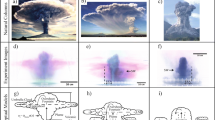Abstract
We present results from a numerical investigation of subaqueous eruptions involving superheated steam released through a lake mimicking the volcanic setting at Mt. Ruapehu. The simulations were conducted using an adaptive mesh, multi-material, hydrodynamics code with thermal conduction SAGE, (Simple Adaptive Grid Eulerian). Parameters investigated include eruption pressure, lake level and mass of superheated vapor. The simulations produced a spectrum of eruption styles from vapor cavities to radial jets that resulted in hazards that ranged from small-scale waves to high amplitude surges that reached and cascaded over the edge of the crater rim. There was an overall tendency for lake surface activity to increase (including wave amplitude) with increasing mass of superheated vapor and eruption pressure. Surface waves were induced by the formation and collapse of a gas cavity. The collapse of the cavity is considered to play a major role in the characteristic features observed during a subaqueous eruption. The additional mass of superheated vapor produced a larger cavity that displaced a larger area of the lake surface resulting in fast moving surges upon the collapse of the cavity. High lake levels (>90 m) appear to suppress the development of explosive jetting activity when eruption pressures are <10 MPa. At very large eruption pressures (>10 MPa), vertical jets and radial ejections of steam and water can occur in water depths >90 m. Less explosive eruption styles can produce hazardous events such as lahars by the outward movement of surface waves over the crater rim.







Similar content being viewed by others
References
Barberi F, Bertagnini A, Landi P, Principe C (1992) A review on phreatic eruptions and their precursors. J Volcanol Geotherm Res 52:231–246
Belousov A, Belousova M (2001) Eruptive process, effects and deposits of the 1996 and the ancient basaltic phreatomagmatic eruptions in Karymskoye lake, Kamchatka, Russia. In: White JDL, Riggs NR (eds) Volcaniclastic sedimentation in lacustrine settings. Blackwell Sciences, Oxford, pp 35–60
Branan N (2008) Tracking deadly lahars; a new dataset provides the best evidence yet for research hoping to learn how to predict these torrential mudflows. Geotimes 53:28–30
Bulletin of the Global Volcanism Network (BGVN) (1991) Caldera lake bubbling; burned vegetation, Vol. 16:07. Smithsonian Institute.
Christenson BW (1994) Convection and stratification in Ruapehu Crater Lake, New Zealand: implications for a Lake Nyos gas release eruption. Geochem J 28:185–197
Colvin S, Rose WI, Escobar D, Gutierrez E, Montalvo F, Olmos R, Palma J, Varekamp J, Patrick M (2008) Crater Lake Evolution During Volcanic Unrest: Case Study of the 2005 Phreatic Eruption of Santa Ana Volcano, El Salvador Eos Trans. AGU, 89(53), Fall Meet. Suppl., Abstract V44A-06.
Dibble RR (1974) Volcanic seismology and accompanying activity of Ruapehu volcano, New Zealand. In: Civetta L, Gasparini R, Luongo G, Rapolla A (eds) Physical volcanology. Elsevier, Amsterdam, pp 49–85
Fazlullin SM, Ushakov SV, Shuvalov RA, Aoki M, Nikolaeva AG, Lupikina EG (2000) The 1996 subaqueous eruption at Academii Nauk volcano (Kamchatka) and its effect on Karymsky lake. J Volcanol Geotherm Res 97:181–193
Gittings ML, Weaver RP, Clover M, Betlach T, Byrne N, Coker R, Dendy E, Hueckstaedt R, New K, Oakes WR, Ranta D, Stefan R (2008) The RAGE radiation hydrodynamic code. Comput Sci Disc 1(015005):63
Kedrinskii VK (2005) Hydrodynamics of explosions: experiments and models. Springer-Verlag, Berlin, p 362
Kieffer SW (1989) Geologic nozzles. Rev Geophys 27:3–38
Kokelaar BP (1986) Magma-water interactions in subaqueous and emergent basaltic volcanism. Bull Volcanol 48:275–289
Kokelaar BP, Durant GP (1983) The submarine eruption of Surtla (Surtsey, Iceland). J Volcanol Geotherm Res 19:239–246
Koyaguchi T, Woods AW (1996) On the formation of eruption columns following explosive mixing of magma and surface-water. J Geophys Res 101:5561–5574
Lecointre J, Hodgson K, Neall V, Cronin S (2004) Lahar-triggering mechanisms and hazard at Ruapehu Volcano, New Zealand. Nat Hazards 31:85–109
Manville V, Hodgson KA, Houghton BF, Keys JR, White JDL (2000) Tephra, snow and water: complex sedimentary response at an active snow capped stratovolcano, Ruapehu, New Zealand. Bull Volcanol 62:278–295
Mastin LG (1995) Thermodynamics of gas and steam-blast eruptions. Bull Volcanol 57:85–98
Mastin LG (1997) Evidence for water influx from a caldera lake during the explosive hydromagmatic eruption of 1790, Kilauea Volcano, Hawaii. J Geophys Res 102:20093–20109
Mastin LG, Witter JB (2000) The hazards of eruptions through lakes and seawater. J Volcanol Geotherm Res 97:195–214
Ruapehu Surveillance Group (RSG) (1996) Volcanic eruption at a New Zealand ski resort prompts reevaluation of hazards. Eos, Transactions, AGU 77:189
Self S, Wilson L, Nairn IA (1979) Vulcanian eruption mechanisms. Nature (London) 277:440–443
Sherburn S, Bryan CJ, Hurst AW, Latter JH, Scott BJ (1998) Seismicity of Ruapehu, New Zealand, 1971–1996: a review. J Volcanol Geotherm Res 88:255–278
Smithsonian Institute (SI) (2009) Types of Processes Gallery – Magma meets water. Global Volcanism Program. http://www.volcano.si.edu/world/tpgallery.cfm
Vergniolle S. Mangan M (2000) Hawaiian and Strombolian eruptions, in: Encyclopedia of Volcanoes. In: Sigurdsson H (ed). Academic Press, p 447.
Wohletz KH (1986) Explosive magma-water interactions: thermodynamics, explosion mechanisms, and field studies. Bull Volcanol 48:245–264
Zimanowski B, Büttner R, Lorenz V (1997) Premixing of magma and water in MFCI experiments. Bull Volcanol 58:491–495
Acknowledgements
This project was funded by the National Science Foundation through grant #EAR-9614228. We would like to thank Richard Wendlandt for his review of the manuscript.
Author information
Authors and Affiliations
Corresponding author
Additional information
Editorial responsibility: J. Phillips
Rights and permissions
About this article
Cite this article
Morrissey, M., Gisler, G., Weaver, R. et al. Numerical model of crater lake eruptions. Bull Volcanol 72, 1169–1178 (2010). https://doi.org/10.1007/s00445-010-0392-5
Received:
Accepted:
Published:
Issue Date:
DOI: https://doi.org/10.1007/s00445-010-0392-5




